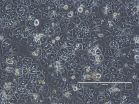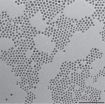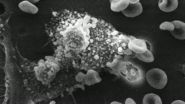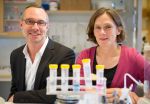(Press-News.org) A triple-punch of antibodies both prevented hepatitis C infection and wiped out the disease after it had established itself in laboratory mice, according to a study led by Princeton University researchers. Instead of delivering the three antibodies directly, the researchers administered a genetic "instruction set" that, once in a cell, developed into antibodies that target the portions of the virus that do not mutate.
Mice treated with the antibody genetic code resisted becoming infected with hepatitis C when they were exposed to the virus, the researchers reported in the Sept. 17 issue of the journal Science Translational Medicine. The researchers also gave the antibodies to mice that already were infected and found that, in many cases, the infection disappeared to levels below detection.
Hepatitis C affects roughly 170 million people worldwide and causes chronic liver damage and cancer. The virus is transmitted to humans via contact with contaminated blood during intravenous drug use or medical procedures. Attempts to develop a hepatitis C vaccine have been hampered by the virus's ability to mutate into numerous subtypes. This genetic diversity is a barrier to developing traditional vaccines, which work by eliciting an immune response against a specific protein or other feature on the surface of the viral particle. These protein targets frequently change when the virus mutates.
To get around this problem, the researchers selected antibodies known to target parts of the virus that tend not to change during mutation, explained lead author Alexander Ploss, an assistant professor in Princeton's Department of Molecular Biology. Such antibodies are called "broadly neutralizing" because they deactivate a variety of genetic subtypes. The ones used in the study were discovered by co-author Mansun Law and his team at the Scripps Research Institute in La Jolla, California.
Rather than injecting the actual antibodies — which can be degraded before reaching their targets — the researchers injected the genetic instructions for making the three antibodies. These instructions consist of the antibodies' genetic codes, or DNA, each linked to the DNA for a benign virus called adeno-associated virus (AAV). This virus acts as a ferry that brings the antibody genes into cells, a delivery technique pioneered by co-author David Baltimore and colleagues at the California Institute of Technology.
Once inside the cells, the genetic codes were translated by the cell's machinery into hepatitis C antibodies, which were excreted into the bloodstream where they attached to the proteins on the viral surface to inactivate them.
The investigators found that mice injected with the AAV-antibody particles went on to develop high and sustained levels of the antibodies against the virus in their blood, and these antibodies protected them from becoming infected when they were later exposed to the virus. "The treatment is a single intramuscular injection that results in high quantities of antibodies in circulation for several months," Ploss said.
The researchers also tried the AAV-antibody treatment on mice that already had a hepatitis C infection. "We weren't sure we would see any results because the antibody can only neutralize viruses that are outside of cells, whereas viral replication is taking place inside the cell, but we decided to try it," Ploss said. "The surprising thing was that within several weeks we saw a decrease in the level of virus in the blood, and in many of the mice, their virus level went below the limit of detection."
Ploss cautioned that the studies in mice would have to be replicated in human clinical trials, a step that could be a long way off. But new approaches for preventing hepatitis C are needed given how widespread the virus is in many parts of the world. Roughly eight out of every 10 people with the virus develop a chronic infection that leads to progressive liver disease and scarring. Yet most infected individuals do not display symptoms for a decade or more. A drug that came on the market in 2013 can cure the disease, but the high cost may prevent or delay widespread use, especially in developing countries.
Michael Houghton, a faculty member at the University of Alberta who, with colleagues, discovered the hepatitis C virus in 1989, said that the research by Ploss and his co-authors shows potential for developing an effective and affordable treatment for the virus.
"This work is very important since it shows that a combination of neutralizing antibodies against the hepatitis C virus can restrict viral spread in the liver thereby ameliorating, and possibly curing, chronic infection," said Houghton, who was not involved in the current study but is familiar with it. "The current work opens up the possibility of treating more patients in a less expensive way and also gives the patient and clinician more treatment options for a disease that affects 170 million people worldwide."
The study also provides evidence for the use of antibody-based strategies to prevent hepatitis C infection, Ploss said. "Much of the current research on vaccines is focused on stimulating the part of the immune system that involves T cells [which are white blood cells with a central role in the body's response to pathogens]," Ploss said, "but our study suggests that broadly neutralizing antibodies could be an important component of an effective hepatitis C vaccine."
The ability of the antibody to remove an existing infection may shed light on how the virus maintains a chronic infection in humans, Ploss said. "Our results seem to suggest that to sustain a persistent infection, the virus must continually infect new cells rather than relying on an existing set of infected cells," he said. "When we inject antibodies that destroy the viral particles, we may be breaking this chain of infection. This suggests that long-term treatment with broadly neutralizing antibodies could be effective at treating existing infection."
Because hepatitis C virus is a human infection that does not naturally occur in other animals, the researchers used two strains of mice with human-like livers that were developed by Ploss and colleagues at Rockefeller University in New York City, including the study's first author, Ype de Jong, now an assistant professor of medicine at the Weill Cornell Medical College. In one strain, the mouse-liver cells express human molecules required for viral uptake, while in the strain developed with de Jong the mice livers contain human cells.
INFORMATION:
In addition to the authors mentioned above, the study included graduate student Benjamin Winer and research specialist Sherif Gerges of Princeton University; Marcus Dorner, Michiel Mommersteeg, Jing Xiao, Kevin Vega, Rachael Labitt, Bridget Donovan and Charles Rice of Rockefeller University; Alejandro Balazs and Dennis Burton of the Ragon Institute of MGH, MIT and Harvard; Erick Giang, Justin Robbins of the Scripps Research Institute; Anuradha Krishnan and Michael Charlton of the Mayo Clinic College of Medicine, and Luis Chiriboga of New York University Medical Center.
The study, "Broadly neutralizing antibodies abrogate established hepatitis C virus infection," was published Sept. 17 in the journal Science Translational Medicine. Support for the work came from grants from the National Institute of Diabetes and Digestive and Kidney Diseases; the National Institute for Allergy and Infectious Disease (grant nos. K08DK090576, R01AI072613, R01AI099284, R01 AI10730101, and R01AI071084); the National Cancer Institute (grant no. R01CA057973); the Bill and Melinda Gates Foundation; the Starr Foundation; the Greenberg Medical Research Institute; the Richard Salomon Family Foundation; the Ronald A. Shellow, M.D. Memorial Fund; the MGM Mirage Voice Foundation; Gregory F. Lloyd Memorial contributions; and anonymous donors.
Genetic 'instruction set' for antibodies knocks down hepatitis C in mice
2014-09-25
ELSE PRESS RELEASES FROM THIS DATE:
On the road to artificial photosynthesis
2014-09-25
The excessive atmospheric carbon dioxide that is driving global climate change could be harnessed into a renewable energy technology that would be a win for both the environment and the economy. That is the lure of artificial photosynthesis in which the electrochemical reduction of carbon dioxide is used to produce clean, green and sustainable fuels. However, finding a catalyst for reducing carbon dioxide that is highly selective and efficient has proven to be a huge scientific challenge. Meeting this challenge in the future should be easier thanks to new research results ...
Study: Widespread vitamin D deficiency in thyroidectomy patients
2014-09-25
DETROIT – A new study from researchers at Henry Ford Hospital in Detroit finds widespread vitamin D deficiency among patients who undergo a thyroidectomy, potentially putting them at greater risk for developing dangerously low blood calcium levels after surgery.
Among the patients in the Henry Ford study, 40 percent had low vitamin D levels prior to surgery. Those more likely to be vitamin D deficient are individuals older than age 50, African Americans, Hispanics and patients undergoing surgery for hyperthyroidism.
"The issue of vitamin D deficiency in patients who ...
How to make stronger, 'greener' cement
2014-09-25
CAMBRIDGE, Mass--Concrete is the world's most-used construction material, and a leading contributor to global warming, producing as much as one-tenth of industry-generated greenhouse-gas emissions. Now a new study suggests a way in which those emissions could be reduced by more than half — and the result would be a stronger, more durable material.
The findings come from the most detailed molecular analysis yet of the complex structure of concrete, which is a mixture of sand, gravel, water, and cement. Cement is made by cooking calcium-rich material, usually limestone, ...
BUSM researchers find NAS treatment needs standardization
2014-09-25
(Boston) – When it comes to treating infants with neonatal abstinence syndrome (NAS), researchers from Boston University School of Medicine (BUSM) believe the care for these infants should be consistent and objective, with standardized assessment tools and evidence to back up pharmacologic and nonpharmacologic treatment choices.
The review paper, which is published online in Addiction Science & Clinical Practice, highlights the need for more research in this field to optimize care for both infants and their mothers.
NAS is a collection of signs and symptoms infants ...
Fecal microbiota transplantation recommended for treatment of C. difficile
2014-09-25
(Vienna, October 26, 2014) The transplantation of faecal microbiota from a healthy donor has been shown in recent clinical studies to be a safe and highly effective treatment for recurrent Clostridium difficile (C. difficile) infection and is now recommended in European treatment guidelines.1,2 Faecal microbiota transplantation (FMT) has emerged as a revolutionary, potentially life-saving treatment for this common, difficult-to-treat infection, and is showing promise in the management of other microbiota-related conditions.3,4
Presenting at the 22nd United European Gastroenterology ...
In the face of uncertainty, the brain chooses randomness as the best strategy
2014-09-25
AUDIO:
Editor Karen Carniol interviews Dr. Alla Karpova on her latest Cell paper.
Click here for more information.
Past experience is usually a reliable guide for making decisions, but in unpredictable and challenging situations, it might make more sense to take risks. A study published by Cell Press September 25th in the journal Cell shows that, in competitive situations, rats abandon their normal tactic of using past experience to make decisions and instead make random choices ...
How the brain gains control over Tourette syndrome
2014-09-25
Tourette syndrome is a developmental disorder characterized by involuntary, repetitive, and stereotyped movements or utterances. Now researchers reporting in the Cell Press journal Current Biology on September 25 have new evidence to explain how those with Tourette syndrome in childhood often manage to gain control over those tics. In individuals with the condition, a portion of the brain involved in planning and executing movements shows an unusual increase compared to the average brain in the production of a primary inhibitory neurotransmitter known as GABA.
The paradoxical ...
Modified vitamin D shows promise as treatment for pancreatic cancer
2014-09-25
VIDEO:
Salk scientists find that a vitamin D-derivative makes tumors vulnerable to chemotherapy.
Click here for more information.
LA JOLLA—A synthetic derivative of vitamin D was found by Salk Institute researchers to collapse the barrier of cells shielding pancreatic tumors, making this seemingly impenetrable cancer much more susceptible to therapeutic drugs.
The discovery has led to human trials for pancreatic cancer, even in advance of its publication today in the journal ...
How physical exercise protects the brain from stress-induced depression
2014-09-25
Physical exercise has many beneficial effects on human health, including the protection from stress-induced depression. However, until now the mechanisms that mediate this protective effect have been unknown. In a new study in mice, researchers at Karolinska Institutet in Sweden show that exercise training induces changes in skeletal muscle that can purge the blood of a substance that accumulates during stress, and is harmful to the brain. The study is being published in the prestigious journal Cell.
"In neurobiological terms, we actually still don't know what depression ...
Brain chemical potential new hope in controlling Tourette Syndrome tics
2014-09-25
A chemical in the brain plays a vital role in controlling the involuntary movements and vocal tics associated with Tourette Syndrome (TS), a new study has shown.
The research by psychologists at The University of Nottingham, published in the latest edition of the journal Current Biology, could offer a potential new target for the development of more effective treatments to suppress these unwanted symptoms.
The study, led by PhD student Amelia Draper under the supervision of Professor Stephen Jackson, found that higher levels of a neurochemical called GABA in a part ...



